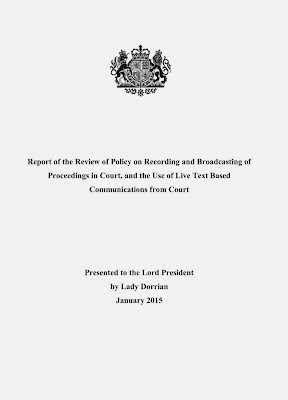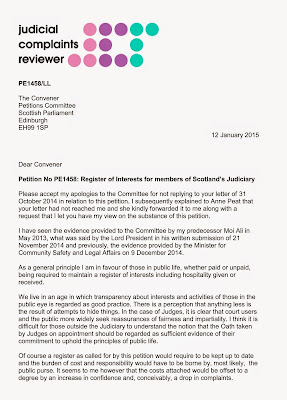 Cameras & tweets in Scotland’s courts – under judicial terms only. CAMERAS and tweets could be allowed in Scotland’s courts, according to the findings of a review carried out by Court of Session judge Lady Dorrian on recording and broadcasting of proceedings in court, and use of live text-based communications.
Cameras & tweets in Scotland’s courts – under judicial terms only. CAMERAS and tweets could be allowed in Scotland’s courts, according to the findings of a review carried out by Court of Session judge Lady Dorrian on recording and broadcasting of proceedings in court, and use of live text-based communications.
The proposals to introduce television and other digital media to courts on a limited, controlled basis, come almost twenty three years after Lord Hope - Scotland’s top judge in 1992 issued a statement to the media he was “considering the television question for some time and now believed it was not in the public's long-term interest for restrictions to remain.”
Accepting the limited proposals for members of the media to film and tweet in court, Scotland’s current top judge Lord President Brian Gill (72) said: “I am grateful to Lady Dorrian and her group for having carried out this exercise so thoroughly. These well-considered recommendations have the support of the judges. I accept all of the recommendations. They are entirely appropriate in the contemporary world. My office will now prepare guidance on the implementation of Lady Dorrian’s report.”
However, Gill – who previously threatened judicial censorship of journalists access to documents and court hearings in a fit of pique against the media last year - said journalists will only be granted use of digital media in courts if they register with the Scottish Court Service.
In a speech to a conference on Digital Justice this week, Lord Gill – who is currently fighting a two year battle with the Scottish Parliament against proposals to create a register of judges interests, wealth and links to big business - made it clear any member of the press who was going to tweet or make use of digital equipment must do so on the court’s terms only. Gill also said anyone not registered with the courts could not tweet unless the judge hearing the case gave permission to do so.
Gill said: “Journalists who register with the Scottish Court Service to gain access to the electronic portal-based system, should also be required to undertake compliance with the Contempt of Court Act. Journalists so registered should be permitted to use live text-based communication. Any person who is not on the register should require the permission of the presiding judge.”
And, in a separate submission to the consultation, an unidentified Court of Session judge who backs the proposals to introduce cameras said there would have to be tight controls on how cases were filmed.
The anonymous judge wrote: “Educating the film company regarding the nature of court proceedings the paramount importance of the interests of justice, and cultivating a relationship of trust with the film company so that the risk of erroneous impressions/misrepresentations, is minimised.”
In summary, the report recommends the following:
*Filming of civil and criminal appeals, and legal debates in civil first instance proceedings, such as judicial review or procedure roll hearings, should be allowed for live transmission. Subsequent news broadcasting and documentary film-making should be allowed subject to clear and comprehensive guidelines.
*The court should allow criminal trials to be filmed for documentary purposes in certain circumstances, subject to the safeguards referred to in the report. Cases involving children, sexual offences and vulnerable witnesses should not be filmed.
*No live transmission or filming for subsequent news broadcast should be allowed for criminal first instance business or for civil proceedings involving witnesses.
*For subsequent news broadcasts, the delivery of sentencing remarks of the judge should be permissible, with filming focused only on the sentencing judge.
* Filming of criminal trials for live transmission should not be allowed.
*In civil cases at first instance, filming for documentary purposes only should be allowed, but should exclude certain groups such as family cases and those involving asylum seekers.
*A structured approach to considering applications to film.
*All filming should be subject to robust, clear and comprehensive guidelines.
*Journalists who register in advance with the Scottish Court Service should be permitted the use of live text-based communications such as Twitter from court, subject to guidelines which will be issued in due course.
The consultation and review – chaired by Lady Dorrian, comprised almost exclusively a judicial membership of Lord Bracadale, Lord Woolman, Sheriff Principal Stephen, and Sheriff Drummond. The group was supported by: Christopher Nicholson, Deputy Legal Secretary to the Lord President; Elizabeth Cutting, Head of Judicial Communications; Steven D’Arcy, Head of Strategy and Governance, Judicial Office for Scotland.
While the move to bring more transparency to Scotland’s courts is a welcome one, no substantive explanation has been given for hold ups in televising courts or why it has taken over two decades to address earlier statements in 1992 by former top judge Lord Hope on the introduction of cameras and other technology to Scotland’s antiquated courts – branded “Victorian” and ‘unfit for purpose’ by Gill himself in the Civil Courts Review.
During 1992, Lord Hope, the then Lord President, in effect opened Scotland's courtroom doors to the cameras when he announced, through the Principal Clerk of the Justiciary in Edinburgh's supreme courts, that modern technology had now advanced to a state 'where proceedings in court could be televised without undue interference in the conduct of proceedings'. Twenty Three years later in 2015, the glacial pace of change in Scotland’s courts once again promises occasional cameras & tweets, but only when judges deign it in their interests or perhaps, the interests of justice - to allow.
And, despite receiving over £80million pounds a year from public coffers to run the Scottish Courts Service, and multi million pound blank cheques to fund items such as the recent £60 million refurbishment of Parliament House in Edinburgh – Lord Gill’s seat of power, it is a fact public records on what goes on in the civil courts are hard to come by, with findings routinely anonymised where vested interests including lawyers are concerned of being identified in dodgy cases where judges secretly linked to litigants, law firms & big business, are not serving the interests of justice.
TOP JUDGE ISSUED THREAT TO BAN MEDIA IN COURT:
During the summer of 2014, in a bizarre fall out with the press, Scotland’s top judge Lord Brian Gill issued an edict threatening to ban journalists and the press from accessing court papers and hearings.
Lord Gill’s warning to the media read as follows:
 NOTICE: ADVANCE ACCESS OF THE MEDIA TO COURT DOCUMENTS
NOTICE: ADVANCE ACCESS OF THE MEDIA TO COURT DOCUMENTS
1. For some time the Court has been reviewing the practice of allowing journalists an opportunity to see complaints and indictments for note-taking purposes before cases call in court.The review was necessary because of significant concerns arising from the Data Protection Act 1998 (“DPA”) in relation to the disclosure of personal data and sensitive personal data in these documents.
2. The current practice gives journalists an opportunity to attend and report on noteworthy cases; but it is now clear that the information being disclosed is excessive for this purpose.
3. In due course the courts will move to an electronic portal-based system that will enable the media to access securely information about forthcoming cases and, in time, other information such as reporting restrictions. This will provide sufficient information for reporting purposes but will ensure that the court will comply with the requirements of the DPA.
4. In the interim the current practice will continue, but on the strict understanding that no information obtained from a complaint or indictment is to be published before a case calls in court. In the light of recent breaches of that understanding, the media are reminded of their responsibilities in the matter.
Brian Gill Lord Justice General Edinburgh 30 July 2014







